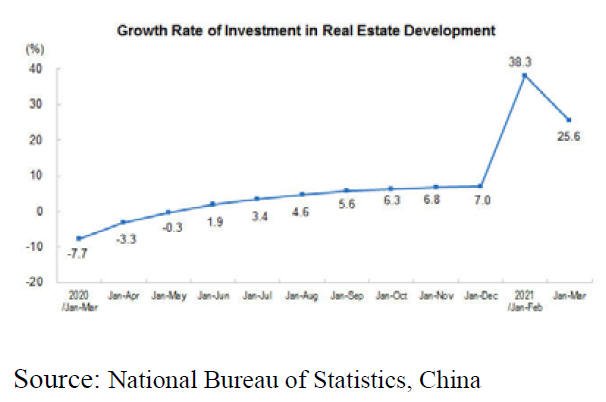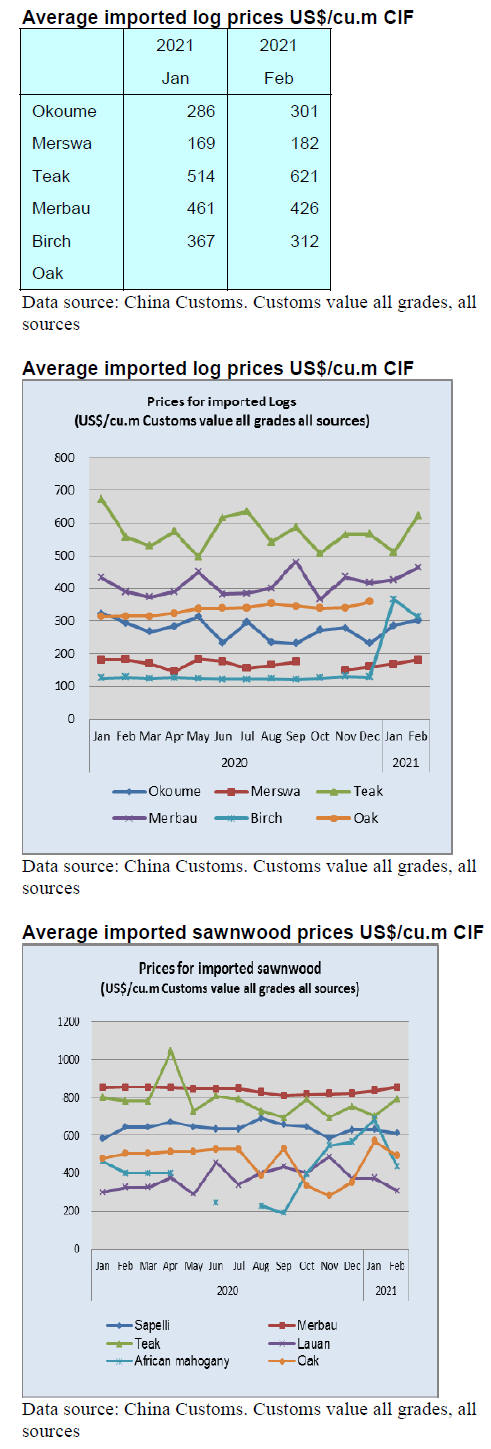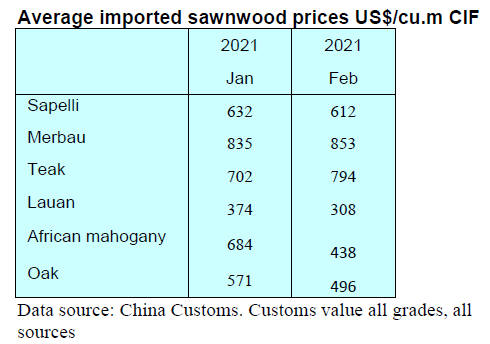US Dollar Exchange Rates of
10th
May
2021
China Yuan 6.4166
Report from China
Household income and consumption in the first
quarter of 2021
China¡¯s National Bureau of Statistics has reported that in
the first quarter of 2021 the average per capita disposable
income was 9,730 yuan, an increase of almost 14% year
on year maintaining an upward trend. The per capita
disposable income of urban residents was 13,120 yuan, an
increase of 12% while that of rural residents was 5,398
yuan, an increase of 16%.
See:
http://www.stats.gov.cn/english/PressRelease/202104/t20210419_1816562.html
In the first quarter 2021 average per capita consumption
was 5,978 yuan, up almost 18% year on year. Expenditure
on housing accounted for around was 1,345 yuan, an
increase of 9% year on year and accounted for 22.5% of
Q1 per capita consumption. Expenditure on other goods
and services increased of 24% and accounted for 2.3% of
all expenditure.

Real estate development in the first quarter
2021
In the first quarter 2021 real estate investment increased
by 25.6% year on year. First quarter investment in
residential properties increased almost 29% year on year
and investment in land by real estate development
enterprises increased 17% year on year and average prices
also increased by the same amount.

Policies aimed at cooling the housing market appear
to be
working as price increases have slowed in Shanghai and
Beijing. The China daily has commented that there was
firm demand in the major cities during the Labour Day
holiday, an indication that homebuyers prefer living in the
country's top-tier cities.
See:
http://epaper.chinadaily.com.cn/a/202105/06/WS609333e9a31099a234355e92.html
Radiata and kauri plywood not sanctioned by US
The US government has announced that radiata pine and
kauri plywood products manufactured in China can be
exported to the US. Also, China¡¯s laminated veneer
lumber (LVL) is not subject to US anti-dumping and antisubsidies
policies.
This kind of LVL is defined as: a product with a length of
not more than 2450mm, a width of not more than 50mm
and a thickness of not more than 50mm used for door
stiles and rails.
See:
https://www.chinafloor.cn/news/diban/news-484949.htm
Rapid growth of furniture industry in Nankang
Furniture manufacturing is a pillar of the economy in
Nankang District, Ganzhou City in Jiangxi province and
the rapid growth of the sector that began in 2016
continues. The Nankang furniture industry cluster
expanded output from RMB100 billion to RMB200 billion
in 4 years. It is forecast that the output value will exceed
RMB500 billion in three to five years and the cluster will
become a significant force in the international market in
the near future. In order to achieve the development target
of RMB500 billion for furniture industry, the following
opinions and suggestions are put forward:
Leader groups, expert groups and core enterprise
development groups will be established to further
promote the rapid realisation of the development
target.
Leading furniture enterprises should be
strengthened to drive investment in industrial
development.
Policies for intelligent manufacturing should be
formulated to promote industrial transformation.
Raw material inputs and output should be
diversified.
Policy support should be provided to promote the
building of the Nankang Furniture Brand Pavilion
to improve sales and brand awareness.
Nankang is promoting the establishment of a Nankang
Furniture University to create a talent pool to support the
sustainable development of the furniture industry.
In other news from Nankang, it has been reported that
furniture makers in the district are, for the first time
embedding smart chips in the vertical furniture surface to
facilitate identification in support of blockchain
technology. The chip allows customers may know all
information on the furniture product such as production
and processing, logistics distribution, product sales and
raw materials.
The debut of intelligent chips will further enhance brand
influence and added value and strengthen the
competitiveness of Nankang furniture products.
See:
https://m.thepaper.cn/baijiahao_12459216
Rise in China¡¯s wooden door production but exports
drop
According to the Market Prosperity Index for China¡¯s
wooden doors in 2020, due to the influence of Chinese
New Year factors combined with the COVID-19
epidemic, the index from the first to the second quarter
2020 was trending down. However, in June, with the
resumption of production, the gradual recovery of the
consumer market and increasing demand for large-scale
projects, the index became positive.
The total value of China¡¯s wooden door output rose 3% to
RMB157 billion in 2020. Among the various categories of
doors the share of engineered doors increased
significantly. Online sales of wooden doors in 2020
increased 50%.
The value of China¡¯s wooden door exports fell 8% year on
year to US$589 million in 2020. The top six provinces
with export values of more than US$30 million were
Guangdong (US$131 mil.), Zhejiang (US$119 mil.),
Liaoning (US$110 mil.), Shandong (US$87 mil.), Fujian
(US$62 mil.) and Jiangsu (US$37 mil.).
There was a 9% rise in exports from Fujian Province and
an 18% increase in Jiangsu Province but the value of
wooden doors exports in Guangdong, Zhejiang, Liaoning
and Shandong fell.
The top 6 export markets for China¡¯s wooden doors in
2020 were the US (23%), Japan (14%), Hongkong (13%),
UK (7%), Canada (4%) and Romania (4%).
See:
https://house.huanqiu.com/article/42PQAIK7CNt
Rise in wood product exports in Hulunbuir City
According to Manzhouli Customs, in the first quarter of
2021, the volume of wood product exports from Hulunbuir
City was 3,287 tonnes valued at US$3.937, up 22% in
volume and 36% in value. The products were exported to
Japan, South Korea and Germany and included mainly
wooden disposable chopsticks, wooden doors and window
frames and wooden multilayer panels.


|